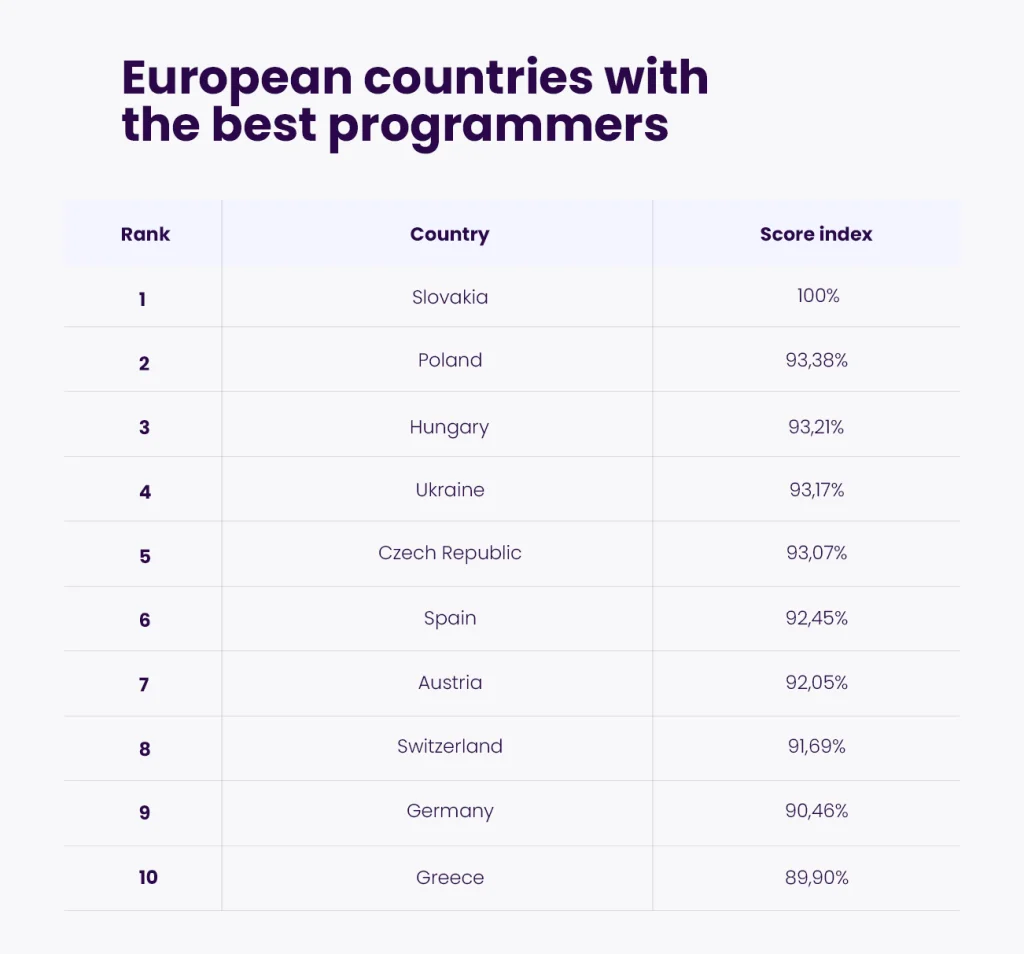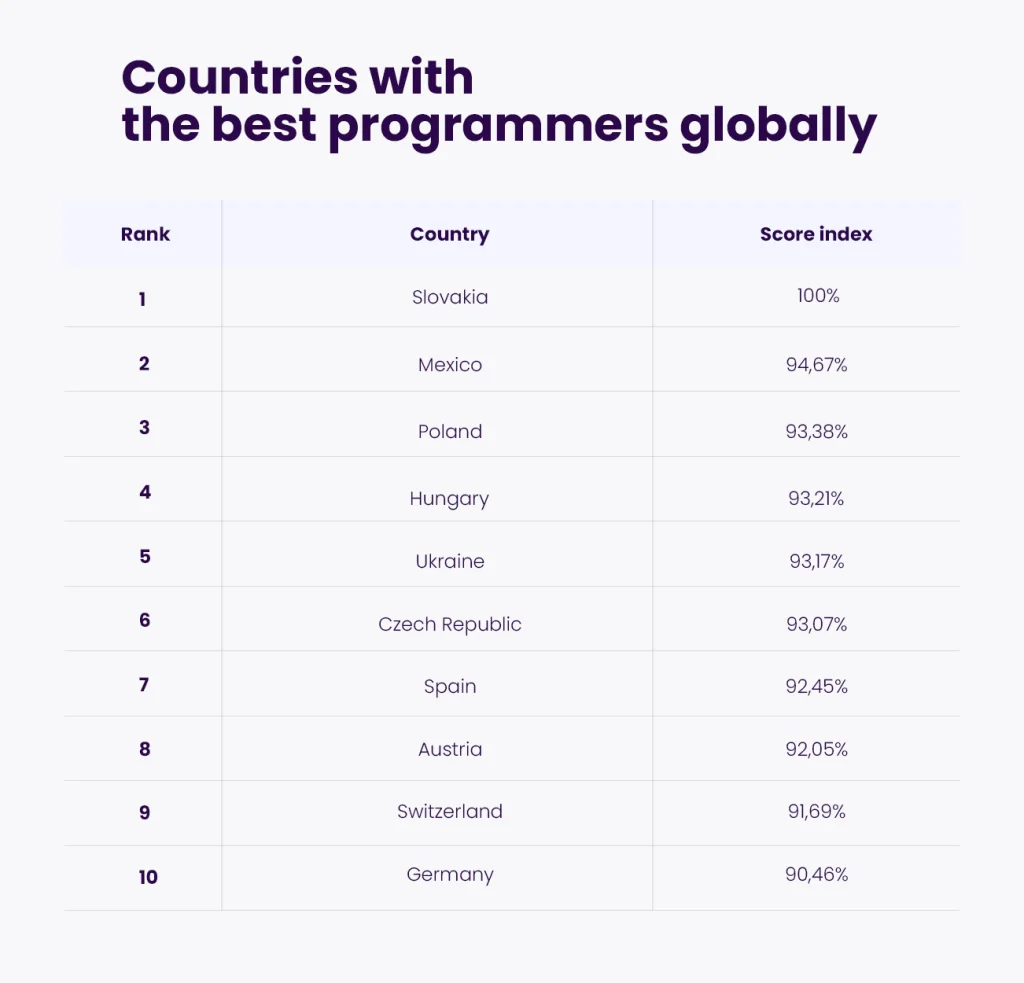Are you looking for a software house to create your app? Nowadays, thanks to outsourcing services, the whole world is at your disposal. You can opt for locally-based services or choose nearshore or offshore development. Whatever your decision is, you will see for yourself that every part of the world plays by their own rules, which often translates into pricing differences, caused mainly by the economic situation in the region as well as varying skill levels of developers.
Moreover, there are a lot of outsourcing models: staff augmentation, nearshore development, offshore development. Sounds scary, huh? Wondering which option will work best for you? No worries, today we will explain it all.
How much do software companies charge per hour?
To put it simply, we can divide the world into four regions regarding the cost of software development: Europe, Asia, North America, and South America. These are the main regions that we will look at today in terms of service costs, developers’ competencies, and English language capabilities.
How much do software developers in Europe charge?
In Europe, the pricing ranges between $40 to $85 per hour. Typically, West Europe is much more expensive than Central and Eastern Europe. The latter tends to be the most affordable. Obviously, the exact pricing will vary between countries and even regions. The language barrier is not typically a problem, as English is taught at a high level in the majority of European countries, and software houses usually expect their developers to have a high-level working proficiency of English not to be confined to the borders of their own country.
How much do software developers in Asia charge?
Asia is known to be an outsourcing hub and is very often people’s first thought when they hear the word “outsourcing”. Developers’ hourly rates start at $20 and reach $40 per hour. These affordable and tempting prices frequently attract companies from all over the world and are the main reason to outsource their project to India or Vietnam.
One of the biggest challenges when it comes to collaboration with Asian companies is the sheer number of vendors offering development services, so finding a reliable partner is like finding a needle in the haystack. It’s not impossible, but with the vast discrepancy in levels of experience, skill and professionalism, it is rather good luck than excellent due diligence to find the truly good Asian development agencies. We know the struggle is real because many of our clients have approached us after a bad experience with an Asian company, with poor quality code, out-of-date libraries, weak documentation and many crucial features not working properly. On the flip side, a number of companies have collaborated successfully with Indian, Vietnamese or Filipino vendors and continue to outsource their projects to Asia.
How much do software developers from Latin America charge?
Latin American companies also can offer less expensive IT services. The hourly rates are around $45-80, which is similar to European prices. In this case, communication remains one of the most significant challenges, as Spanish is the main language spoken in Latin America, and speaking English is often a problem. Moreover, the region has never been notorious for its excellent developers, something that might change in the future. Still, collaboration with Latin American vendors can be challenging, and there is a good possibility that it won’t bring about the desired results.
How much do software developers in North America charge?
We’ve mentioned North America, but let’s focus on the USA. That’s the world’s technology hub and your most obvious choice when looking for software development services. Without a doubt, hourly rates in the USA are the highest in the world. The average rates in the USA start with $80-150 per hour in the case of junior developers, and can reach $110-175 per hour for a senior developer’s work. The average cost of software development can be twice as much as in Europe, and that’s why so many companies opt for offshoring and collaboration with European providers.
Hourly rates for different IT specialists
Here are the average hourly rates for developers in different world regions.
| Seniority Level | Europe | Asia | Latin America | North America |
| Junior Developer | 25-65 | 20-45 | 35-65 | 80-150 |
| Regular Developer | 40-75 | 25-55 | 40-70 | 100-175 |
| Senior Developer | 55-85 | 35-60 | 50-85 | 110-175 |
We should also mention other specialists that are involved in software development projects. Without them, creating digital products would be impossible. Check out how much they charge per hour in various locations:
| Position | Europe | Asia | Latin America | North America |
| Business Analyst | 35-90 | 30-65 | 40-75 | 75-150 |
| Project Manager | 40-80 | 35-70 | 50-85 | 75-160 |
| Graphic Designer | 35-105 | 25-45 | 35-85 | 100-200 |
| DevOps | 50-100 | 35-55 | 45-100 | 100-200 |
| QA Engineer | 40-75 | 25-50 | 45-75 | 75-120 |
Why is it so popular to outsource to Europe?
When taking into account different parts of the world, Europe, and Central Europe in particular, is nowadays the most attractive region in terms of IT development.
There are multiple reasons for this:
- Central Europe is much cheaper than the USA or Western Europe (although a bit more expensive than Latin America and Asia),
- The high level of developers’ knowledge and skills results in high-quality, clean code (more about that to follow), and meticulous documentation,
- The ratio between price and quality is much better than in most other regions.
Therefore, when considering value for money in terms of price versus code quality, Central European countries are the leading choice for those who are in search of app developers.
Which country has the best developers?
Every year, various portals try to establish which place has the best programmers. Poland and other Eastern European countries are consistently rated high and placed within the top fives.
According to SkillValue 2019 report, Poland is the third country in the world when it comes to software developers and the second in Europe. Countries like Slovakia, Hungary, Ukraine and the Czech Republic are also appreciated for their skilled talents. Globally, Mexico is known for their coders, too.


You might think the USA, UK or Germany would hold these places, but they are ranked much lower. It’s surprising, but hear us out. Smaller countries used to be underestimated and not spoken about in discussions about quality development, but it has changed in recent years. The IT world praises Polish, Hungarian, Ukrainian and many other European specialists a lot. Companies from around the world are willing to outsource to these destinations. It’s worth mentioning that in these countries, you will most likely get superb code along with attractive prices compared to Western Europe or North America. This is something to really consider when picking a vendor.
What does a professional development team look like?
One of the main success factors in software development is the team that will participate in the project. At itCraft, there is always a Project Manager, a team of developers which, depending on the project scope, will include native iOS and Android developers or cross-platform developers, as well as frontend, backend and full-stack developers that are indispensable for building the solution. UX/UI Designers are engaged during the design phase of the app interface, and QA Engineers are responsible for testing the software and the ultimate quality of the final product.
All medium to large projects kick off with a UX Design workshop. These workshops are the initial stage of the development process, vital for understanding the business objectives and goals of the project, defining the technology necessary to deliver those objectives and determining the MVP (Minimum Viable Product – the leanest form of the app which the market will accept). This phase is conducted by Business Analysts, Tech Leads or System Architects and Senior UX/UI Designers who discuss and consult on the best possible solution from business, technology and user experience perspectives.
During the development phase, only the team members required to complete the tasks in the sprint backlog are engaged. Suppose the project is of a larger scope. In that case, the team is expanded with Regular Developers added to assist Senior Developers to meet the deadlines and more QA Engineers to ensure thorough testing. Example estimations of various-size projects can be found on our pricing page, where you can also learn more about app development costs.
Different types of outsourcing
You are already familiar with the budget required to hire developers in different parts of the world. You know where you can look for competent specialists, and additionally, you are aware of what kind of specialists should (or can) be included in the team working on your project. Now it’s time to explain and analyze the various types of outsourcing that you can choose from.
Staff Augmentation vs Managed Teams
I could describe these two types of outsourcing separately, but they are actually easier to understand when explained as one. Outsourcing itself means subcontracting a company to perform a given job. In terms of software development, we subcontract human resources to turn your project into reality.
The main difference between staff augmentation and managed teams outsourcing is that staff augmentation means involving the vendor’s employees as part of the in-house team. However, in the case of team outsourcing, you delegate part or the whole project to the service provider. There is also an option to choose full custom software development with the widest scope of outsourcing services.
Imagine that you want to create an enterprise app for production process management. Let’s say you have your own team that is able to create this app, but you are lacking an iOS developer. It doesn’t make sense to hire a new person as the developer is only needed for a small part of the project, so outsourcing would be your best option. What you can do is contact a software house and subcontract a developer who in fact will still work in this software house, but you will pay for the hours worked on your project. This is what staff augmentation is.
Now let’s say you have a manufacturing company and you want to create an app, but you don’t employ any developers and don’t see any sense in creating new job positions only for the duration of the project, or maybe you have an in-house team able to develop an Android app, but not the iOS version. Therefore, you can outsource your project (or part of it) to an external provider. In this case, we are talking about managed teams outsourcing.
Nearshore outsourcing
Nearshore development is yet another kind of outsourcing that, at a closer look, is simply a buzzword. We can keep using the phrases explained above: ‘project outsourcing’ or ‘specialist/developers outsourcing’. If there are additional factors, for instance, the team that works on the outsourced project is located in the same region or works in a similar time zone, then this type of outsourcing is called nearshore development or nearshore outsourcing.
Offshore development
Offshore development, in turn, is the exact opposite of nearshore outsourcing. The characteristic traits of this type of outsourcing are the highly-skilled developers, but at the same time, in many cases, much lower service prices thanks to different costs of living in a given country which is typically located in a remote part of the world. Offshore development outsourcing has a lot in common with another popular term: overseas outsourcing, and it speaks for itself.
What are the software costs factors?
To sum up, the cost of custom software development can vary dramatically and depends on many factors, like which part of the world you outsource to, whether you have your own in-house team and only need to outsource part of the project or you want to delegate the whole development process, and last but not least, the seniority level of developers that will be involved in your project.
Junior developers will always be significantly cheaper than senior developers. In many cases, the investment in the higher hourly rate for the more experienced developer is well worth making. The seniority level is not just a pretext to charge more, but the experience of senior developers allows them to work faster and more productively, and in the long run, become more cost-efficient compared to a team comprised of juniors.
There is much more to discuss when it comes to software development costs and pricing factors. That’s why you can find lots of interesting reads on this topic on our blog. We encourage you to keep expanding your knowledge and check out our other blog posts, where you can learn more about software development cost, like in How Much Does it Cost to Make An App? or different types of contracts in Fixed Price vs. Time and Materials contract – the pros and cons. Also, learn whether technology outsourcing makes sense for startups.
And if you need a competent team to take care of your IT project – don’t hesitate and reach out. We will help you make your ideas come true and build a robust software solution that will fulfill all your business goals.





